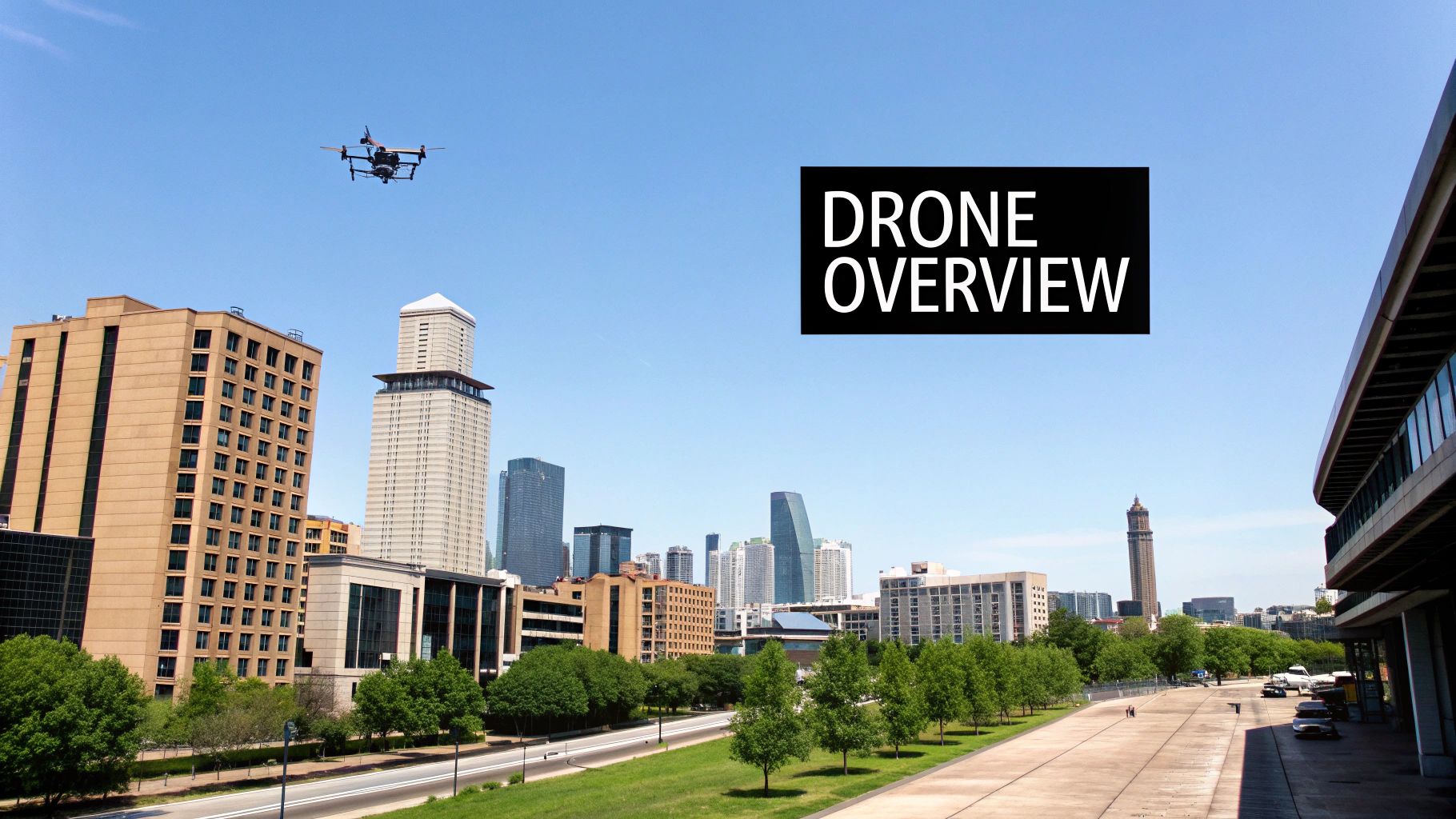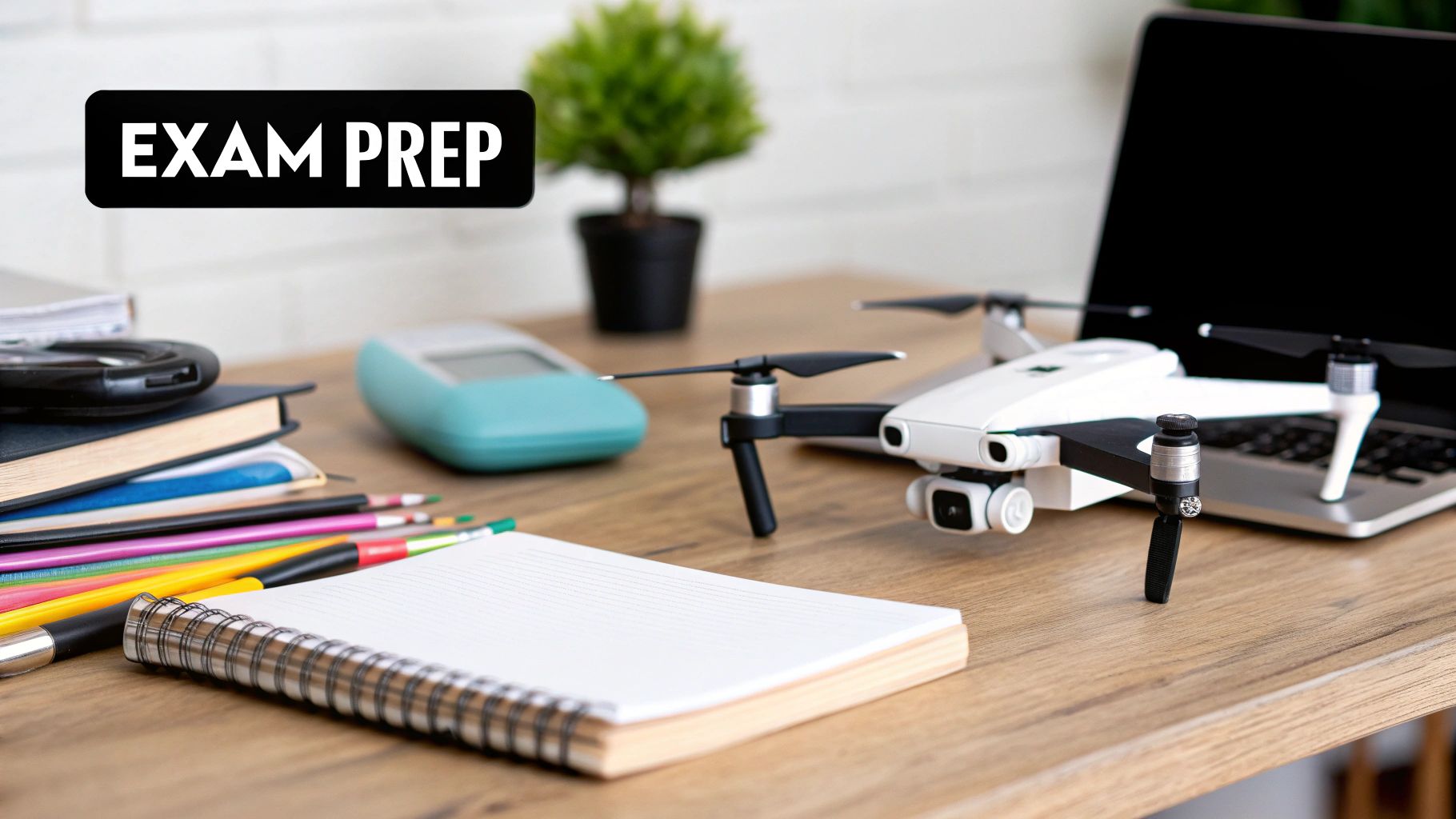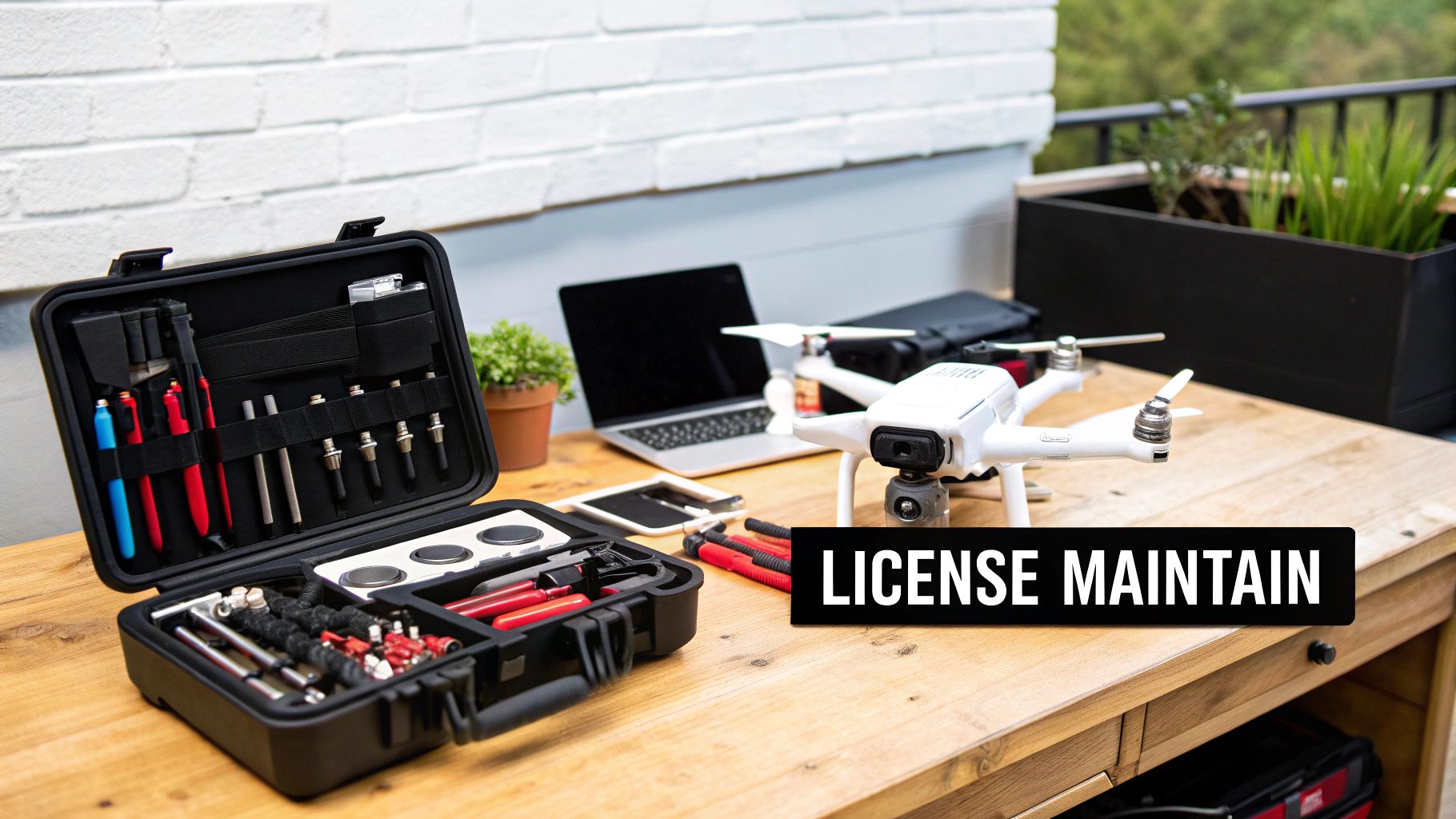Drone License Requirements: Your Quick FAA Guide
- A.E. Williams

- Apr 17
- 10 min read
Navigating Drone License Requirements: Core Concepts

Understanding drone license requirements can be tricky. This section simplifies these complexities by explaining fundamental concepts, such as the difference between registration and licensing, and how drone classifications impact your legal responsibilities. We'll give you a clear grasp of the essential terminology and regulations surrounding drone operations.
Drone Registration Vs. Licensing: A Key Distinction
Many new drone pilots confuse registration with licensing. Drone registration is a basic step, much like registering a car, and often depends on the drone's weight. Licensing, however, focuses on the pilot and confirms their qualifications to operate a drone, particularly for commercial purposes.
This important difference defines your operational limits and responsibilities. For instance, commercial operators usually need a specific license to fly legally. This distinction is fundamental to understanding all other drone regulations.
Weight Classifications and Their Impact
Drone weight significantly affects the rules that apply. Lighter drones, typically used recreationally, may face fewer restrictions. However, as drone weight increases, so do the regulatory requirements. This often means obtaining specific licenses and adhering to operational limitations.
For example, heavier drones, often used commercially for aerial photography or package delivery, require stricter adherence to rules concerning airspace authorization and operational procedures. This weight-based system ensures appropriate safety measures based on potential risks.
The requirement for drone registration is now a cornerstone of many countries' regulatory frameworks. In the United States, the Federal Aviation Administration (FAA) mandates that drones weighing over 0.55 pounds (250 grams) be registered. As of 2025, the FAA has over 1 million registered drones, a substantial increase since the regulations began.
This includes both recreational and commercial drones, with specific rules like maintaining a line of sight and flying below 400 feet. Similar registration requirements exist in other major markets like Canada and Europe, with specific weight limits and operational restrictions. Learn more here.
Hobby Vs. Commercial Use: Defining the Line
Another key aspect of drone license requirements is the difference between hobby and commercial use. Hobbyist flying generally has fewer restrictions. However, even seemingly harmless activities, like posting drone footage on monetized social media accounts, can unintentionally classify your operation as commercial.
This subtle difference can significantly change your legal responsibilities, potentially requiring a commercial drone license. Understanding these nuances ensures you operate legally and avoid penalties. This knowledge is essential for responsible drone ownership and safe airspace integration.
Commercial Vs. Recreational Drone Requirements Decoded

Thinking of using your drone for more than just weekend fun? The rules change significantly when you cross the line from hobbyist to professional drone pilot. Understanding these differences is crucial for staying on the right side of the law and avoiding hefty penalties. This section breaks down the key distinctions between commercial and recreational drone operations.
Monetization Matters: When Hobby Becomes Business
Many people believe they can freely use their recreational drone for commercial purposes. This is a misconception. Even using the same drone, actions like posting footage on monetized social media or accepting any payment for drone services shifts your operations into the commercial category.
Let's say you're capturing breathtaking aerial photos of local landscapes. If you sell those prints or license the footage, you've transitioned to a commercial drone operation. This shift requires a Part 107 Remote Pilot Certificate, the FAA's license for commercial drone pilots.
Part 107: Your Key to Commercial Drone Operations
The Part 107 license opens doors for commercial pilots. It signifies you've met the FAA's standards for knowledge and skill in safe commercial drone operations. This includes understanding airspace regulations, weather conditions, and emergency procedures.
Commercial operators with a Part 107 certificate can also apply for waivers to expand their operational capabilities. These waivers are essential for activities like night flights, flying over people, and beyond visual line of sight (BVLOS) operations. Such capabilities are often critical for commercial applications such as infrastructure inspections, aerial photography, and precision agriculture.
To help clarify the distinctions between commercial and recreational drone operations, let's examine a comparison table summarizing key requirements:
Commercial vs. Recreational Drone Requirements Comparison
A comprehensive comparison of the licensing, testing, and operational requirements between commercial and recreational drone operations.
Requirement Type | Commercial Operations | Recreational Operations |
|---|---|---|
Licensing | Part 107 Remote Pilot Certificate required | Generally, no specific pilot license required, but registration may be mandatory |
Testing | FAA Aeronautical Knowledge Test required | May require completion of an online knowledge quiz |
Airspace Restrictions | More stringent airspace authorizations may be needed | Generally, restricted from certain airspace classes |
Operational Limitations | Maximum altitude, speed, and distance limitations apply | Similar limitations apply, often stricter in certain areas |
Insurance | May be required depending on the nature of operations | Generally not required but recommended |
This table simplifies the key regulatory differences. Remember to consult official sources for a complete understanding of regulations in your jurisdiction.
Penalties For Non-Compliance
Operating commercially without proper certification can lead to significant penalties. These include substantial fines and possible legal action. For unauthorized commercial drone operations, fines can run into thousands of dollars, severely impacting your business.
Properly classifying your drone activities and obtaining the right certification is not just a legal obligation; it’s a vital business decision. This protects you from penalties and establishes your credibility as a responsible drone operator. Knowing the rules ensures safe, legal, and responsible flight operations.
Mastering the Part 107 Certification Process

The Part 107 Remote Pilot Certificate is essential for anyone wanting to fly drones commercially. Issued by the FAA, this certification confirms you have the knowledge and skills to operate drones safely and legally for business. This section will guide you through obtaining this important credential, from the initial application to the knowledge test and beyond.
Understanding the Requirements
Several key steps are involved in getting your Part 107 certification. First, you must be at least 16 years old and able to read, speak, write, and understand English. You will also need to pass a Transportation Security Administration (TSA) background check. This check ensures that all commercial drone pilots meet specific security standards. These initial requirements are the first steps toward becoming a certified commercial drone pilot.
Navigating the Application Process
Once you meet the initial requirements, you can begin the application itself. This process involves registering for an FAA Tracking Number (FTN) and completing the online application through the Integrated Airman Certification and/or Rating Application (IACRA) system. The IACRA system gathers the necessary personal information and formally begins the certification process.
Preparing for the Knowledge Test
The central part of the Part 107 certification is the Aeronautical Knowledge Test. This exam covers a wide range of topics, from airspace regulations and weather interpretation to emergency procedures and general drone operations. Proper preparation is essential for passing.
Effective study strategies involve using FAA-approved study materials and taking practice exams. For example, many find understanding sectional charts and airspace classifications particularly challenging, so dedicate ample time to these concepts. Practicing with tests that mimic the actual exam environment is also highly recommended. This familiarizes you with the format and helps you assess your readiness.
Taking the Test and Receiving Your Certificate
You'll take the knowledge test at an FAA-approved Knowledge Testing Center. After successfully completing the test, you will receive a temporary certificate. Your official Part 107 certificate will then arrive by mail in a few weeks. This marks your official start as a commercial drone pilot!
Maintaining Your Certification
The Part 107 certificate isn't a one-and-done deal; it requires renewal every 24 calendar months. Renewal involves completing a recurrent knowledge test, proving your continued understanding of current drone regulations. This ensures certified pilots stay up-to-date with the latest rules and safety procedures. Staying current with your certification is vital for operating legally and upholding professional standards.
Global Drone License Requirements and Compliance

Drone regulations vary considerably across the globe. This poses challenges for international drone operators. This section explores how drone license requirements differ between key regions and offers strategies for maintaining compliance when operating across borders.
EU vs. FAA: Two Different Approaches
The European Union and the United States, under the Federal Aviation Administration (FAA), regulate drones differently. The EU employs a risk-based category system. Drones are classified into Open, Specific, and Certified categories based on their potential risk. Each category has unique requirements for both the drone and its operator.
The FAA, however, focuses on the type of operation, such as commercial or recreational. This approach emphasizes pilot certification and operational restrictions based on the drone’s intended use. Understanding these key differences is essential for anyone involved in international drone operations.
Reciprocity and New Licensing Processes
Some countries recognize drone licenses issued by other nations – a concept known as reciprocity. This simplifies international operations if your current certification is valid elsewhere. However, reciprocity isn’t universally accepted.
Many countries require foreign drone operators to obtain a completely new license. This involves navigating their specific regulations, which can be a complex undertaking. Thorough research on the specific requirements of your destination is crucial before any international drone activity.
Operational Limitations and Registration
Licensing isn’t the only factor to consider. Operational limitations can vary widely by region. These might include restrictions on flight altitude, maximum flight distance, and permitted flight zones. Some countries have established no-fly zones around sensitive areas or have specific rules for night flights.
Furthermore, some countries require registration even for recreational drone use. Similar to registering a vehicle, this process allows authorities to track drones operating within their jurisdiction. Non-compliance with these local rules can result in penalties.
Certification for drones, particularly for higher-risk operations, is becoming increasingly common globally. In the EU, drones in the Open category must comply with class certification as outlined in (EU) 2019/945, whereas higher-risk operations fall into Specific or Certified categories requiring more stringent certifications and risk assessments. Similarly, in the U.S., while Part 107 doesn’t require drone certification for small operations, many commercial operations need thorough risk assessments and certifications. This trend toward increased regulation reflects a global movement towards stricter safety and operational standards as drone technology progresses. Explore this topic further here.
Strategies for International Compliance
Navigating international drone regulations demands careful planning. Before operating in a new country, research their specific requirements. This includes licensing, operational restrictions, and registration procedures. Consulting with aviation authorities or local drone organizations can offer valuable insights. Staying informed about regulatory changes and seeking expert advice will help international drone operators maintain compliance, safety, and legality.
Industry-Specific Drone License Requirements That Matter
Beyond the basic Part 107 license, specialized drone credentials and operational approvals are often required for specific industries. This section explores the varying drone license requirements across different sectors, offering a closer look at the unique demands of each.
Filmmaking and Photography
Capturing breathtaking aerial footage in filmmaking and photography often requires going beyond standard drone operations. A Part 107 license is fundamental, but additional permissions, such as waivers, are often needed.
For instance, capturing a city's vibrant nightlife requires a night waiver, permitting safe and legal after-dark flights. Filmmakers also frequently seek permission for closed set flights, allowing complex maneuvers in controlled spaces.
Construction and Infrastructure Inspection
Drones play a vital role in construction and infrastructure inspection, aiding in site surveys, progress monitoring, and detailed structural assessments. This often necessitates flying near or over people, requiring specialized waivers.
A waiver for flight over people is critical, prioritizing worker and public safety during these close-proximity operations. Beyond visual line of sight (BVLOS) waivers are also increasingly sought after for large-scale inspections of pipelines or bridges.
Agriculture
Precision agriculture utilizes drones for various tasks, including crop monitoring, aerial spraying, and livestock management. A Part 107 license is the foundation, but supplementary training and certifications may be necessary for specialized applications.
Operating drones with spraying systems may require specific certifications to ensure safe and efficient application of agricultural products. BVLOS operations are also becoming essential for managing large farms, demanding appropriate waivers and careful operational planning.
Public Safety
Drones provide critical support to public safety agencies in search and rescue missions, crime scene analysis, and emergency response. Rapid and effective deployment is paramount.
This requires not only a Part 107 license but also a thorough understanding of local regulations and airspace restrictions, as well as securing any necessary airspace authorizations. Adherence to specific protocols for operating in emergency situations is crucial. As technology advances, real-time crime centers and advanced drones like the Skydio X10 are transforming emergency response, enhancing both efficiency and safety.
Navigating Industry-Specific Requirements
Understanding and adhering to industry-specific regulations is crucial for commercial drone pilots. The following table summarizes some key requirements:
To help illustrate these requirements, let's take a look at the following table.
Industry-Specific Drone License Requirements
Industry | Basic License Required | Additional Certifications | Common Waivers Needed |
|---|---|---|---|
Filmmaking | Part 107 | Specialized cinematography training | Night operations, closed set flights |
Construction | Part 107 | UAS inspection certification | Flight over people, BVLOS |
Agriculture | Part 107 | Agricultural drone application certification | BVLOS, airspace authorizations for aerial spraying |
Public Safety | Part 107 | Emergency response drone training | Airspace authorizations for specific missions, potentially BVLOS waivers for wider coverage |
Infrastructure Inspection | Part 107 | Specialized infrastructure inspection training | BVLOS, flight over critical infrastructure |
This table provides a basic overview of industry-specific requirements. Always consult the FAA and relevant industry bodies for the most current and complete information. Staying informed and obtaining the necessary credentials allows drone pilots to operate safely, legally, and efficiently.
Overcoming Common Drone Licensing Roadblocks
The journey to getting your drone license, whether for fun or for profit, can be tricky. Many aspiring pilots hit roadblocks along the way. This section addresses these common challenges and offers practical solutions to help you navigate the process.
Tackling the Knowledge Test
The knowledge test, essential for a Part 107 commercial drone license, is a significant hurdle for many applicants. Topics like sectional charts and airspace classifications are often particularly challenging.
One effective approach is to break these complex subjects down into smaller, more digestible pieces. Visual aids, such as online tutorials and interactive maps, can significantly improve your grasp of airspace structures. Plus, focusing on practice tests that address these specific problem areas can boost your chances of success.
Expediting Application Processing
Drone license processing times can sometimes lag, especially during busy periods. These delays can be frustrating for applicants eager to get their drone operations off the ground.
Meticulous preparation is key to speeding things up. Make sure your application is complete and accurate, with all required documentation included. Double-checking everything minimizes the risk of delays caused by missing information. Also, directly contacting the relevant licensing authority to confirm receipt and track your application's progress can help manage expectations.
Documenting Experience for Waivers
Certain drone operations, like night flights or flights over people, require waivers. A critical part of the waiver application is demonstrating your flight experience and operational procedures.
Keeping detailed flight logs is crucial. These logs should include dates, times, locations, and the types of flights conducted. Developing clear and concise standard operating procedures (SOPs) for specialized drone operations strengthens your application and showcases your commitment to safety.
Navigating Background Checks and Previous Violations
Background checks are standard procedure in the drone licensing process. Applicants with past aviation violations or criminal records may face additional scrutiny.
Honesty is the best policy. Openly addressing any past issues and providing clear explanations with supporting documentation can help alleviate concerns. In some cases, seeking legal advice may be wise to navigate more complex situations.
Managing Application Rejections
While not common, drone license applications can be rejected. This can be discouraging, but understanding the reasons for rejection is the first step towards a solution. The rejection notice typically outlines the specific areas of concern.
Carefully review the reasons given for the rejection. Address the issues thoroughly before reapplying. If you believe the rejection was unjustified, consider appealing the decision. Familiarize yourself with the appeals process and gather supporting documentation to strengthen your case. Persistence is key; don’t give up.
Staying Current with Evolving Regulations
Drone regulations are always changing. Staying informed about updates is essential for maintaining compliance. Regularly check official sources, such as the FAA website, for the latest rules and guidance. Subscribing to industry newsletters and joining drone pilot communities can also help you stay up-to-date.
Want to enhance your drone journey? Check out the resources, product reviews, and expert insights at JAB Drone. We equip you with the knowledge and inspiration you need to explore the skies safely and creatively.




Comments